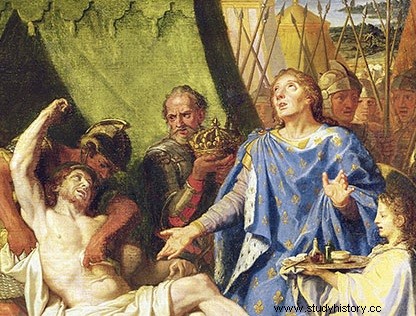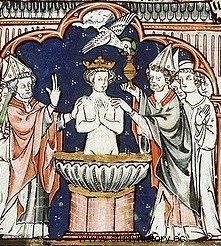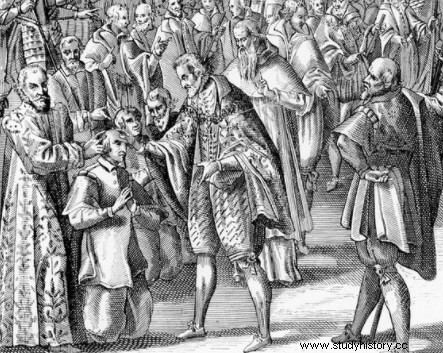 It was during the reign of Louis VI the Fat (1108-1137) that a written document relates for the first time the ceremony of touching the scrofula . The healing of scrofula gradually appears as the prerogative of the kings of France and England:Robert the Pious may have had this power, Philippe I and Louis VI, more certainly, but this is attested by numerous testimonies only at from Saint Louis. In England, Henry II Plantagenet is the first to exercise the touch of scrofula. This practice, based on the attribution to the Christian king of a healing power, continued in France until the coronation of Charles X in 1824.
It was during the reign of Louis VI the Fat (1108-1137) that a written document relates for the first time the ceremony of touching the scrofula . The healing of scrofula gradually appears as the prerogative of the kings of France and England:Robert the Pious may have had this power, Philippe I and Louis VI, more certainly, but this is attested by numerous testimonies only at from Saint Louis. In England, Henry II Plantagenet is the first to exercise the touch of scrofula. This practice, based on the attribution to the Christian king of a healing power, continued in France until the coronation of Charles X in 1824.
What is scrofula?
Sometimes also called scrofula, scrofula refers in medieval language to a condition known today as tuberculous adenitis:it is an inflammation of the lymph nodes of the neck, which swell and suppurate horribly, and it is generally interpreted as the outward sign of genital tuberculosis. This disease seems all the more common at the time as many other phenomena are attached to it. Although contagious, it is not fatal. The greatest risk incurred by the patient is sterility. Susceptible to spontaneous remissions, this condition has long justified the miracle-working power attributed to kings.
The healing of scrofula, a power that arises from the coronation
 People or elite, no one doubted in France, in the 12th century, that the sovereign was capable of curing this disease , to the point that it is sometimes called "royal evil". Yet this belief is recent. It dates from a royal initiative:the transformation of the coronation ceremony, desired by Louis VI to reinforce the charisma of the royal function. Initiative confirmed under his successors, until the final fixation of the ritual at the time of Charles V the Wise, crowned in 1364.
People or elite, no one doubted in France, in the 12th century, that the sovereign was capable of curing this disease , to the point that it is sometimes called "royal evil". Yet this belief is recent. It dates from a royal initiative:the transformation of the coronation ceremony, desired by Louis VI to reinforce the charisma of the royal function. Initiative confirmed under his successors, until the final fixation of the ritual at the time of Charles V the Wise, crowned in 1364.
From 1108, in fact, the prerequisite for any coronation of a king of France is the anointing, that is to say the imposition on the body of the sovereign of an oil whose origin, according to legend, is divine. Also called the Holy Chrism, it comes from the Holy Ampulla, brought by a messenger dove of the Holy Spirit to Bishop Remi of Reims, who first uses it to baptize Clovis, the first king of the Franks. Coming from heaven, it gives the sovereign the religious character that allows him, like Christ, to perform miracles. The rite, born in France with the Carolingians, gives royalty divine legitimacy. It makes the king of France a king-priest, governing the people of God, protecting his churches and, indissolubly, a man raised by God above other mortals, endowed with a radiance and a mysterious power, including that healing.
“The king touches you. God heal you”
Initially, the ceremony is simple and without pageantry. Saint Louis thus touches the scrofulous every day, as soon as they come to ask for it, as long as they wait for him at the end of the mass. From Louis XI however (1461-1483), the sick are grouped together for a single weekly ceremony. It was also in the 15th century that they were required to undergo a brief preliminary medical examination, in order to rule out those suffering from another disease. The Capetians are content to touch the diseased parts with their hands, and then make a sign of the cross over them, or even on the patient's forehead:symbolically, the touch of the king's hand transmits the invisible force that dwells, and the blessing of the king-priest completes the whole.
 From the 16th century, the king accompanies his gesture with a stereotypical formula, "The king touches you, God heal you." Healings, when there are any, obviously appear to us as natural and of psychological origin:the miracle occurs because the subjects are persuaded that it must take place. In the 17th century, the touching of scrofula became one of the most solemn rituals of the monarchy. Accomplished only during the major Christian holidays (Easter, Pentecost and especially Christmas), announced by criers and by way of posters, it takes place most often in the Grande Galerie du Louvre. The sick came there in droves, and foreigners rubbed shoulders with the French, to the point that the house of France was able to exploit the royal miracle to demonstrate its superiority over rival European dynasties. At Pentecost 1715, very shortly before his death, Louis XIV still affected 1,700 scrofulous, proof that, whatever his state of health, the king owes himself to that of his subjects, and cannot shirk his charge. .
From the 16th century, the king accompanies his gesture with a stereotypical formula, "The king touches you, God heal you." Healings, when there are any, obviously appear to us as natural and of psychological origin:the miracle occurs because the subjects are persuaded that it must take place. In the 17th century, the touching of scrofula became one of the most solemn rituals of the monarchy. Accomplished only during the major Christian holidays (Easter, Pentecost and especially Christmas), announced by criers and by way of posters, it takes place most often in the Grande Galerie du Louvre. The sick came there in droves, and foreigners rubbed shoulders with the French, to the point that the house of France was able to exploit the royal miracle to demonstrate its superiority over rival European dynasties. At Pentecost 1715, very shortly before his death, Louis XIV still affected 1,700 scrofulous, proof that, whatever his state of health, the king owes himself to that of his subjects, and cannot shirk his charge. .
A less and less effective miracle
However, the ritual of touch does not have very long to live. Louis XV and Louis XVI still saw thousands of patients pass by, but the belief in miracles did not stand up well to the transformations in mentalities of the pre-revolutionary era. The triumphant rationalism of the Enlightenment alienates the elites from the religious worldview to which this tradition belongs. While the lower classes still revere the thaumaturge king, enlightened minds are incredulous, even downright ironic.
Voltaire thus insolently notes that Louis XIV was not able to cure one of his mistresses suffering from scrofula, although he "touched her very well" . The kings themselves seem to no longer believe in their powers. From Louis XV, the royal formula was reversed in a meaningful way:it became “(May) God heal you, (because) the king touches you”. And Charles X, in 1824, contented himself with saying to the scrofulous:“I brought you words of consolation. I sincerely hope that you recover...”
Royal miracles in England
In medieval and modern Europe, only the kings of England shared the privilege of the kings of France, which caused jealousy and concern from other dynasties. They indeed touched the scrofula from 1276 to 1714. This ritual was in a way the symbolic ground of the long struggle for prestige that the French and English monarchies fought in the Middle Ages. The English ritual resembles the French ritual in the 13th century, then it becomes a true religious liturgy, much more solemn and sumptuous, where the king officiates alongside his chaplain.
The English Plantagenet Monarchy boasts a second privilege, which appeared shortly after the touch of scrofula, at the beginning of the 14th century. Every Good Friday, in the chapel of the palace, the king prostrates himself in front of the altar then deposits beautiful gold and silver coins there which he “redeems” immediately by replacing them with a currency of any value. The king then had rings made with the gold and silver coins, which for a few moments became Church property and thus consecrated. These rings, given by the king, are attributed with the power to heal, especially in the case of epileptic diseases, those who wear them.
To go further
- Touching the Ecrouelles, by Léon Landouzy. ESR, 2006.
- The thaumaturgical kings:A study on the supernatural character attributed to royal power, particularly in France and England, by Marc Bloch. NRF, 1983.
